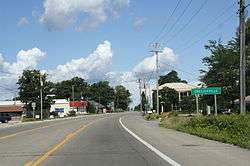Greilickville, Michigan
| Greilickville, Michigan | |
|---|---|
| Census-designated place (CDP) & Unincorporated community | |
|
Sign on M-22 | |
 Location of Greilickville within Leelanau County, Michigan | |
| Coordinates: 44°46′59″N 85°38′19″W / 44.78306°N 85.63861°WCoordinates: 44°46′59″N 85°38′19″W / 44.78306°N 85.63861°W | |
| Country | United States |
| State | Michigan |
| County | Leelanau |
| Township | Elmwood Charter Township |
| Area | |
| • Total | 6.9 sq mi (17.8 km2) |
| • Land | 4.5 sq mi (11.7 km2) |
| • Water | 2.4 sq mi (6.2 km2) |
| Elevation | 584 ft (178 m) |
| Population (2000) | |
| • Total | 1,415 |
| • Density | 314.4/sq mi (121.4/km2) |
| Time zone | Eastern (EST) (UTC-5) |
| • Summer (DST) | EDT (UTC-4) |
| ZIP code | 49684 (Traverse City) |
| Area code(s) | 231 |
| FIPS code | 26-35300[1] |
| GNIS feature ID | 627411[2] |
Greilickville is an unincorporated community in Leelanau County in the U.S. state of Michigan. It is a census-designated place (CDP) used for statistical purposes and has no legal standing as a municipality. The population was 1,415 at the 2000 census.
The area is on Grand Traverse Bay just north of Traverse City and is a part of that city's urban area. The Traverse City Harbor is located in Greilickville. The CDP includes a larger area extending further inland than the settlement concentrated on the waterfront.
History
The area was first known as "Norristown", after Seth and Albert Norris who opened a gristmill there in about 1853. In the mid-1850s, Bohemian native Godfrey Greilick and his sons built a small, water-powered sawmill. Greilick's original name was Gottlieb Greulich and he escaped furtively from his hometown of Chrastava in 1842, because he owed a lot of money. The Greilick brothers built a steam-powered mill in a few years. Until its destruction by fire in about 1907, the mill was one of the most important on Grand Traverse Bay, cutting eight and one-half million feet of hardwood lumber in 1883. Other industries in the nineteenth century included a brickyard, brewery, and tannery. When the Manistee and Northeastern Railroad entered town in 1892, the station was called "Greilicks" and the surrounding community also took this name. In 1961, when Greilickville's population was about 900, a special election was held in sections 28 and 33 of Elmwood Township, including Greilickville, to decide a proposal regarding making those areas a home-rule village called Elmwood. The proposal was defeated by a vote of 238 to 88.
Geography
According to the United States Census Bureau, the CDP has a total area of 6.9 square miles (18 km2), of which 4.5 square miles (12 km2) is land and 2.4 square miles (6.2 km2) (34.59%) is water.
Demographics
At of the 2000 census,[1] there were 1,415 people, 624 households and 431 families residing in the CDP. The population density was 314.4 per square mile (121.4/km²). There were 677 housing units at an average density of 150.4 per square mile (58.1/km²). The racial makeup of the CDP was 97.95% White, 0.64% African American, 0.35% Native American, 0.07% Asian, 0.21% from other races, and 0.78% from two or more races. Hispanic or Latino of any race were 0.57% of the population.
There were 624 households of which 21.5% had children under the age of 18 living with them, 59.5% were married couples living together, 7.2% had a female householder with no husband present, and 30.8% were non-families. 25.3% of all households were made up of individuals and 12.8% had someone living alone who was 65 years of age or older. The average household size was 2.27 and the average family size was 2.67.
18.2% of the population were under the age of 18, 4.8% from 18 to 24, 21.3% from 25 to 44, 31.0% from 45 to 64, and 24.7% who were 65 years of age or older. The median age was 48 years. For every 100 females there were 90.2 males. For every 100 females age 18 and over, there were 87.8 males.
The median household income was $48,269 and the median family income was $51,250. Males had a median income of $45,938 compared with $27,938 for females. The per capita income for the CDP was $30,822. None of the families and 1.2% of the population were living below the poverty line, including no under eighteens and 1.8% of those over 64.

